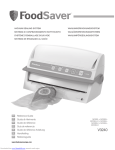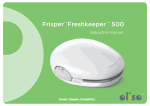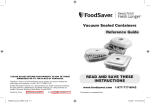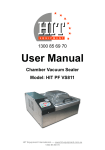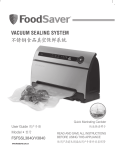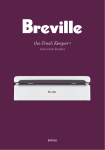Download Tilia Quick Marinator
Transcript
How to Vacuum Package Using Your FoodSaver® Vacuum Packaging Canister ® Vacuum Packaging System Quick Marinator Instructions For Use NOTE: FoodSaver Vacuum Packaging Canisters can only be used with a FoodSaver® appliance that has an Accessory Port. Please check your QuickStart Guide to see if your appliance has one. 1. Place your FoodSaver® appliance on a flat, dry surface and plug the power cord into a standard electrical outlet. 2. Place the item(s) to be vacuum packaged inside the canister. Leave at least one inch (1”) between the contents and the rim of the canister. 3. Wipe rim to ensure it is clean and dry. 4. Place the lid on top of the canister. If the canister has latches, put them in an upright position so that the lid fits on the base. Push the latches downward until they snap into place. 5. Insert one end of the Accessory Hose into the Accessory Port on your FoodSaver® appliance. 6. Insert the other end of the Accessory Hose into the hole on the top of the canister lid. Twist the gray tip of hose while inserting to ensure a tight fit. 7. Follow the steps for vacuum packaging as outlined in your QuickStart Guide. 8. Remove the Accessory Hose from the Accessory Port on the appliance before vacuum packaging in FoodSaver® Bags. Allow hot foods to cool to room temperature before vacuum packaging. Otherwise, the contents may bubble up out of the canister. ® How to Open the FoodSaver Vacuum Packaging Canister To open, press and hold down the gray rubber button in the center of the lid until you no longer hear air escaping. This will release the vacuum and allow you to easily remove the lid. Care and Cleaning Instructions 1. Wash all FoodSaver® accessories in warm water using a mild dishwashing soap. Do not immerse lids in water. 2. Dry thoroughly before using. 3. FoodSaver® Vacuum Packaging Canister bases (but not the lids) are top–rack dishwasher safe. Lids should be wiped down with a damp cloth. 4. FoodSaver® Vacuum Packaging Canisters should not be used in the microwave or freezer. T020-00110 update.indd 1 Vacuum Packaging and Food Safety Vacuum packaging extends the life of foods by removing most of the air from sealed containers, thereby reducing oxidation. Vacuum packaging helps preserve flavor and overall quality. It also helps inhibit the growth of aerobic microorganisms, which can lead to the problems noted below under certain conditions: Mold – Easily identified by its fuzzy characteristic. Mold cannot grow in a low oxygen environment, therefore vacuum packaging can virtually eliminate it. Yeast – Results in fermentation, which can be identified by smell and taste. Yeast needs water, sugar and a moderate temperature to grow. It can also survive with or without air. Slowing the growth of yeast requires refrigeration, while freezing stops it completely. Bacteria – Right conditions, clostridium botulinum (the organism that causes Botulism) can grow without air and cannot be detected by smell or taste. Although it is extremely rare, it can be very dangerous. As with any other storage container, it is important to inspect food for spoilage prior to consuming. To preserve foods safely, it is important to maintain low temperatures. You can significantly reduce the growth of microorganisms at temperatures of 40°F (4°C) or below. Freezing at 0°F (-17°C) does not kill microorganisms, but stops them from growing. For long-term storage, always freeze perishable foods that have been vacuum packaged. It is important to note that vacuum packaging is not a substitute for canning and it cannot reverse the deterioration of foods. It can only slow down changes in quality. It is difficult to predict how long foods will retain their top-quality flavor, appearance or texture because it depends on the age and the condition of the food on the day it was vacuumed packaged. NOTE: Vacuum packaging is NOT a substitute for refrigeration or freezing. Any perishable foods that require refrigeration must still be refrigerated or frozen after vacuum packaging. Preparation Guidelines Vegetables need to be blanched before vacuum packaging. This process stops the enzyme action, which leads to loss of flavor, color and texture. To blanch vegetables, place them in boiling water or in the microwave until they are cooked, but still crisp. Blanching times range from 1 to 2 minutes for leafy greens and peas; 3 to 4 minutes for snap peas, sliced zucchini or broccoli; 5 minutes for carrots; and 7 to 11 minutes for corn on the cob. Then, immerse the vegetables in cold water to stop the cooking process. Finally, dry the vegetables on a towel before vacuum packaging. Cruciferous vegetables (broccoli, Brussels sprouts, cabbage, cauliflower, kale, turnips) naturally emit gases during storage. Therefore, after blanching, they must be stored in the freezer only. IMPORTANT: Uncooked mushrooms, raw garlic and soft cheese should never be vacuum packaged. 7/13/07 11:18:15 AM Tips for Marinating with the Quick Marinator Marinating with your FoodSaver vacuum packaging system opens the pores of your food during the process of vacuuming, so marinating is complete in as little as 20 minutes. Not only is your food infused more quickly – but the marinade also penetrates deeper for more intense flavor! You can create meals in minutes – and won’t get stuck if you forgot to marinate yesterday! In just 20 minutes, you’ll be ready for grilling, roasting or any other method of preparation! ® Recipes Asian Citrus Marinade Beef, Chicken, Fish, Lamb, Pork, or Vegetables 12 / cup orange or pineapple juice 2 1/2 Tbsp. fresh lemon juice 2 1/2 Tbsp. fresh lime juice 1 Tbsp. ginger, peeled and chopped 2 garlic cloves, crushed 1 Tbsp. light brown sugar 14 / cup peanut oil 1 Tbsp. tarragon vinegar 14 / tsp. red pepper flakes (optional for extra spiciness) Whisk all ingredients in a medium bowl until well blended. Korean Marinade Beef, Chicken, Fish, Lamb, Pork, or Vegetables 12 / cup soy sauce 12 / cup mirin 1 Tbsp. fresh ginger, minced 1 Tbsp. garlic cloves, crushed 2 green onions, chopped 2 Tbsp. dark brown sugar 1 Tbsp. orange peel, minced 2 tsp. dark sesame oil Whisk all ingredients in a medium bowl until well blended. Sweet Honey-Basil Marinade Chicken or Pork 14 / cup honey 12 / cup red wine vinegar 2 garlic cloves, crushed 1 large shallot, peeled and roughly chopped 1 Tbsp. soy sauce 2 1/2 Tbsp. orange juice 2 Tbsp. white wine 14 / cup fresh basil, washed and roughly chopped 14 / tsp. salt 14 / tsp. ground black pepper Whisk all ingredients in a medium bowl until well blended. Tarragon Mustard Marinade 14 / cup extra-virgin olive oil 14 / cup dry white wine or vermouth 2 Tbsp. Dijon mustard 2 Tbsp. fresh tarragon, chopped 12 / tsp. salt 12 / tsp. black pepper, freshly ground Whisk all ingredients in a medium bowl until well blended. Makes 11/2 cups; enough for 41/2 pounds of chicken, pork or fish. Texas Bar-B-Que Sauce & Marinade 2 Tbsp. vegetable oil 12 / small white onion, chopped 2 cloves garlic, chopped 12 / cup ketchup 14 / cup cider vinegar 2 Tbsp. soy sauce 2 Tbsp. dark brown sugar 1 Tbsp. Worcestershire sauce 1 tsp. dry mustard 12 / tsp. celery seed In a medium-sized saucepan, heat the oil and sauté the onion and garlic for 5 minutes. Add the remaining ingredients and simmer, stirring frequently, until slightly thickened, about 10 minutes. Cool the marinade before using. Makes 2 cups; enough for 6 pounds of beef, chicken or pork. Cooking Chart Broiling / Grilling Baking Pork Closest to heat source. 12 minutes per inch - turn once. Not recommended. Beef Closest to heat source. 10 minutes per inch - turn once. Not recommended. Shrimp Closest to heat source. 3-4 minutes per side. Bake at 400°F (200°C) for 6-8 minutes. Fish Closest to heat source. 5-6 minutes per inch - turn once. Bake at 400°F (200°C) for 6-10 minutes per inch. Poultry with bone Furthest from heat source. 12-14 minutes per side. Bake at 350°F (175°C) for 25-30 minutes. Poultry without bone Closest to heat source. 4-5 minutes per side. Bake at 350°F (175°C) for 20-25 minutes. Vegetables Closest to heat source. Until tender. Bake at 450°F (230°C) until tender. Troubleshooting If the FoodSaver® Vacuum Packaging Canister will not vacuum: 1. Make sure the rubber gasket rim on the lid is free from food materials. 2. Examine the rim of the canister for any cracks or scratches. Any gaps can prevent the canisters from vacuuming properly. 3. Make sure the canister is not too full for vacuum packaging. Always leave at least one inch (1”) between the contents and the lid. 4. Make sure the Accessory Hose is securely inserted into the Accessory Port on the appliance and in the port on the canister lid. If you need assistance: Call Consumer Services at 1-800-777-5452 or e–mail [email protected]. In Canada, call 1-877-804-5383. FoodSaver® Canisters come in a variety of shapes and sizes which can be used in the refrigerator, on the countertop or in the pantry. T020-00110-000 (06/06) T220-00450 T020-00110 update.indd 2 Printed in China www.foodsaver.com 7/13/07 11:18:16 AM






